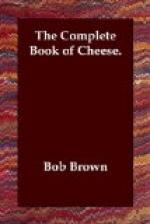A classic mixture with condiments, especially the great peppers from which the world’s best paprika is made. Liptauer is the regional name for Brinza, as well, and it’s made in the same manner, of sheep milk and sometimes cow. Salty and spready, somewhat oily, as most sheep-milkers are. A fairly sharp taste with a suggestion of sour milk. It is sold in various containers and known as “pickled cheese.” (See Chapter 3.)
Lipto
Hungary
Soft; sheep; white; mild and milky taste. A close
relative of both
Liptauer and Brinza.
Little Nippy
U.S.A.
Processed cheese with a cute name, wrapped up both plain and smoky, to “slice and serve for cheese trays, mash or whip for spreading,” but no matter how you slice, mash and whip it, it’s still processed.
Livarot
Calvados, France
Soft paste, colored with annatto-brown or deep red (also, uncommonly, fresh and white). It has the advantage over Camembert, made in the same region, in that it may be manufactured during the summer months when skim milk is plentiful and cheap. It is formed in cylinders, six by two inches, and ripened several months in the even temperature of caves, to be eaten at its best only in January, February and March. By June and afterward it should be avoided. Similar to Mignot II. Early in the process of making, after ripening ten to twelve days, the cheeses are wrapped in fresh laiche leaves, both to give flavor and help hold in the ammonia and other essentials for making a strong, piquant Livarot.
Livlander
Russia
A popular hand cheese. A most unusual variety because the cheese itself is red, not the rind.
Locatelli
Italy
A brand of Pecorino differing slightly from Bomano Pecorino.
Lodigiano, or Lombardo
Lodi, Italy
Sharp; fragrant; sometimes slightly bitter; yellow. Cylindrical; surface colored dark and oiled. Used for grating. Similar to Parmesan but not as fine in quality.
Longhorn
Wisconsin, U.S.A.
This fine American Cheddar was named from its resemblance to the long horn of a popular milking breed of cattle, or just from the Longhorn breed of cow that furnished the makings.
Lorraine
Lorraine, Germany
Hard; small; delicate; unique because it’s seasoned with pistachio nuts besides salt and pepper. Eaten while quite young, in two-ounce portions that bring a very high price.
Lumburger
Belgium
Semisoft and tangy dessert cheese. The opposite of Limburger because it has no odor.
Lunch
Germany and U.S.A.
The same as Breakfast and Fruehstueck. A Limburger type of eye-opener.
Lueneberg
West Austria
Swiss type; saffron-colored; made in a copper kettle; not as strong as Limburger, or as mild as Emmentaler, yet piquant and aromatic, with a character of its own.




